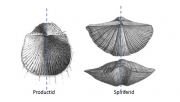
Drawings of two common Tasmanian Permian Brachiopods
Molluscs and brachiopods are shelled animals. Their hard parts make them common in the fossil record.
They are/were widespread, varied and abundant. They live/lived in shallow marine environments, such as beaches, tidal zones and offshore, and are also in rivers and lakes.
Brachiopods (or lampshells) form their own phylum. They were common prior to the end of the Permian, but are less abundant today. They are symmetrical about a central line but have different shaped shells (or valves).
Molluscs have been around since the Cambrian. Three shelled forms of molluscs are common fossils. These include bivalves, with two shells that are the same (e.g clams), cephalopods with straight or coiled shells (octopus, cuttlefish) and gastropods which have coiled shells (snails).
Drawings of two common Tasmanian Permian Brachiopods. The one on the left is Productid variety with a flat top shell (or valve) and a lower scooped valve. It had spines on the shell. The one on the right is a Spiriferid variety shown in plan view (top) and side view (bottom).
The above image is an impression of a Tetrabratulid brachiopod.
Fossil Plant Library
Fossils are not only interesting, intriguing and beautiful, they can also be very useful. They can tell us a lot about the place where the original organisms lived and died. They also inform us about the relative ages of the strata that contain them. Here are some images of fossils to look through to help you identify the ones you have seen or others have collected at the locations you visited.
Please use the Fossil Paleoflora Library to help you answer and engage with the courses assessment task.
Fossil Shell Library
Molluscs and brachiopods are shelled animals. Their hard parts make them common in the fossil record.
They are/were widespread, varied and abundant. They live/lived in shallow marine environments, such as beaches, tidal zones and offshore, and are also in rivers and lakes.
Brachiopods (or lampshells) form their own phylum. They were common prior to the end of the Permian, but are less abundant today. They are symmetrical about a central line but have different shaped shells (or valves).
Molluscs have been around since the Cambrian. Three shelled forms of molluscs are common fossils. These include bivalves, with two shells that are the same (e.g clams), cephalopods with straight or coiled shells (octopus, cuttlefish) and gastropods which have coiled shells (snails).
Drawings of two common Tasmanian Permian Brachiopods. The one on the left is Productid variety with a flat top shell (or valve) and a lower scooped valve. It had spines on the shell. The one on the right is a Spiriferid variety shown in plan view (top) and side view (bottom).
The above image is an impression of a Tetrabratulid brachiopod.
Fossil Bryozoanl Library
Bryozoans are small animals that build their colonies from carbonate minerals. They are readily preserved and have a good fossil record. In the modern, they live in shallow marine environments. and thrive in cold waters. Some genera are also in lakes and rivers.
Two major types are common fossils from Permian strata in Tasmania.
Content is available under the
Creative Commons Attribution Share Alike License.
Privacy Policy | Authors